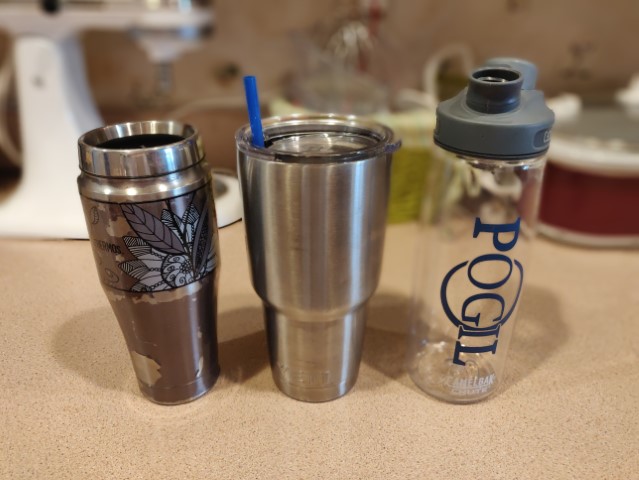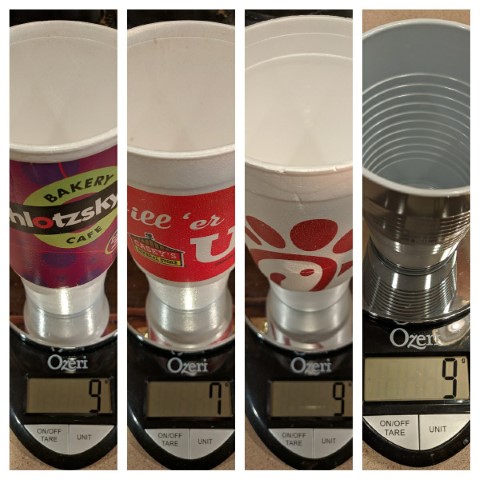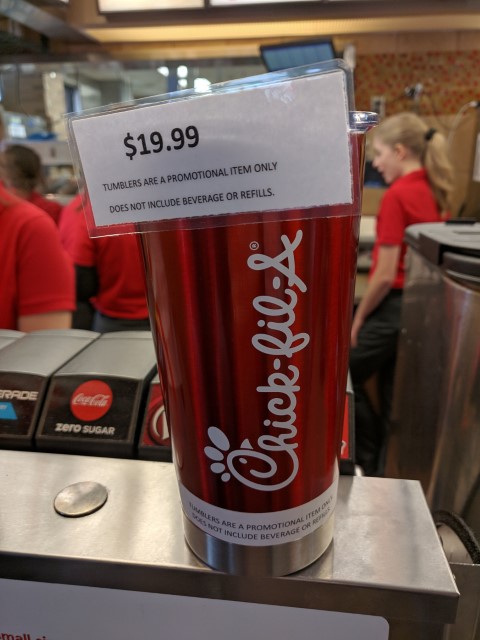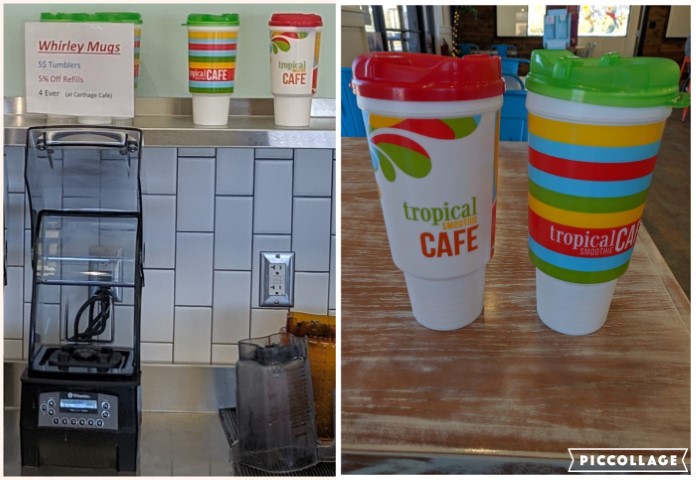In my last post, I wrote about my attempts to avoid disposable cups, particularly styrofoam, and disposable plastic water bottles. I mentioned that we could take a 5-gallon cooler of water for the high school swim team, but it might seem weird. But, inspired by a friend’s comment on the post, I decided to do just that. I found the pump pictured below on the website of a major online retailer with 2-day shipping. I knew there would be a tradeoff, with the waste associated with packaging and shipping the pump offsetting the reduced plastic-water-bottle waste, but I hoped the pump would make a positive impact. I had to sell my kids on the idea, and we compromised — some bottled water for the bus ride, and this pump + purified water for the meet.
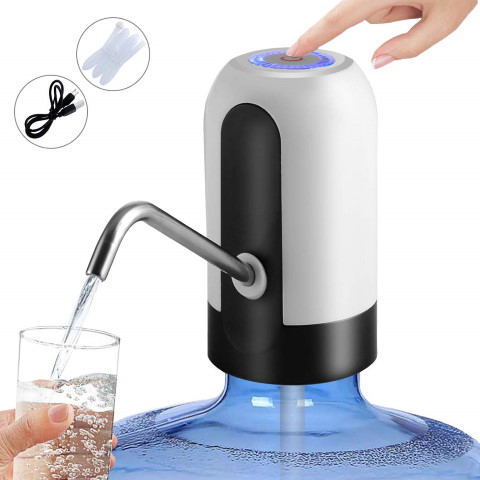
Success! My family already uses refillable 5-gallon water bottles at home for drinking water, so I took a full one of those and this pump. It was a hit. I thought maybe it was just the novelty, but athletes drink lots of water, and are used to carrying their own water bottles to practice. A simple reminder to bring them to the meet was all that was needed.
We weren’t on the schedule to bring snacks for the next meet a week later, but I was at work and my wife texted me to ask where the pump was. Apparently, some of the swimmers had asked if we could bring back the water/pump. They liked it. We were happy to oblige! And, since it was half empty, it was a lot less heavy and easier to haul into the pool area.
The second victory was fun. On my way home after working a long Friday evening officiating a swim meet (not high school), I decided to treat myself to a hot fudge shake from the local dairy and burger joint. I keep a straw in my car to reuse when needed, but I knew that this dairy serves their small shakes in styrofoam cups. However, I also knew that they used to serve them in paper cups, and that they still stocked the paper cups for other things, like soda. I was pretty sure they wouldn’t go for using my own reusable cup — it wouldn’t fit onto the shake mixer machine anyway. So it was time to try out the strategy I had devised.
“I’d like a small hot fudge shake. But I can’t have plastic, so could I have it in a paper cup please?” Aha! I thought, they can’t deny someone who can’t have plastic, which is more or less true, thanks to my commitment.
“So, you want a medium, then?”
“Well, can I just have it in one of those blue cups instead of the styrofoam?”
“A medium?”
Maybe a couple of pictures I found online will help explain.
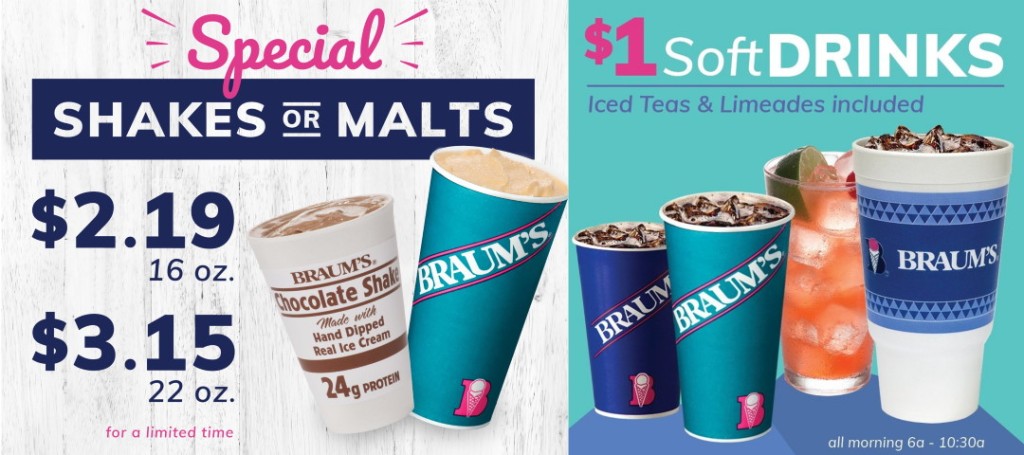
The small comes in styrofoam (with 24g protein! It’s virtually health food!) The medium comes in a teal-colored cup, but that’s sort of blue. The small cup I wanted was the royal blue one. So what did I say?
“A medium will be fine, thanks.”
One thing I didn’t think of — it came with a plastic lid (not pictured). Next time, I’ll just say “no lid.” And I’ll try harder to get the small shake in the blue cup. I could stand to minimize the caloric intake. 🙂
Finally, I’ve been wondering how I can purchase some juice in something other than plastic. Orange juice is a possibility, because you can still get FCOJ at many places. For those of you who don’t recall the movie Trading Places (Sell!, Sell!), FCOJ stands for frozen concentrated orange juice. And I’ve started doing that. But my family is big on cranberry juice. And while American Airlines has no trouble getting cranberry juice (“Is cran-apple OK?”) in aluminum cans, at the local stores, it’s pretty much all plastic.
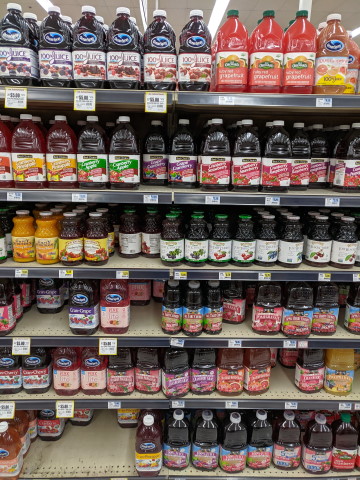
But next to the regular cranberry juice, the cranberry juice cocktail, the cran-peach and white cranberry and cran-grape and cran-cherry and cran-everything — is “all-natural” or “Just Cranberry” or “100% unsweetened cranberry.” You know, the organic cranberry juice. It comes in glass bottles with steel caps. I decided to try some.
My mom tells me that I used to eat whole, raw cranberries out of the bag when I was a kid. While poking them with needle and thread and stringing them with popcorn to make garland for the Christmas tree, I guess I ate more than I strung. So I’m okay with bitter, I guess.
But WOW that 100% unsweetened cranberry “nectar” is potent. I could drink it straight if I had to, but it’s kinda pricey for that, and definitely not sweet. I found that if I dilute it 1:1 or even 1:2 with water, and then add a spoonful of sugar (sing it!), it is pretty much like the pre-mixed name-brand kind. I haven’t done the cost analysis, and the organic juice is significantly more expensive, but with the dilution factor, I think drinking it this way might come out to about the same price per glass. And the color is so beautifully intense! It’s good for mixed drinks as well (add a little to your margarita for a colorful punch!)
As a chemist, I would be remiss if I didn’t mention at this point that the color of cranberry juice is actually due to a color-changing acid-base indicator, and lends itself to some cool DIY science experiments.
Before I wrap up, I’ve learned from some of you that glass recycling isn’t universally available, and that makes me sad. So for you, juice bottled in glass might not be that much better for sustainability than juice bottled in plastic. That is an important issue, but one that I’ll need to save for a future post.
